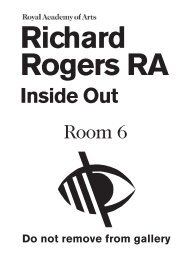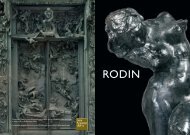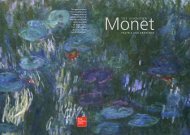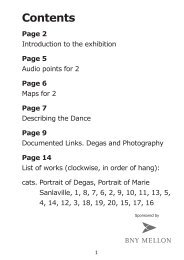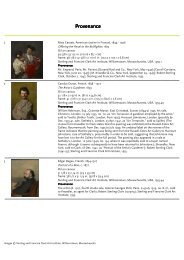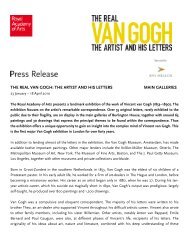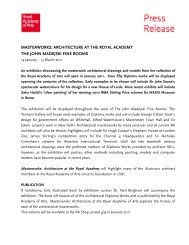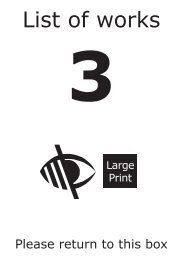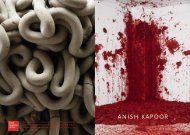EYEWITNESS - Royal Academy of Arts
EYEWITNESS - Royal Academy of Arts
EYEWITNESS - Royal Academy of Arts
Create successful ePaper yourself
Turn your PDF publications into a flip-book with our unique Google optimized e-Paper software.
20<br />
‘The war correspondent has<br />
his stake – his life – in his<br />
own hands, and he can put it<br />
on this horse or that horse,<br />
or he can put it back in his<br />
pocket at the very last<br />
minute. I am a gambler.<br />
Idecided to go in with<br />
Company E in the first wave.’<br />
ROBERT CAPA RECALLING THE<br />
EVENTS OF D-DAY IN HIS<br />
MEMOIR SLIGHTLY OUT OF FOCUS,<br />
1947<br />
fascists – self-styled as ‘Nationalists’ – were opposed by an <strong>of</strong>ten uneasy<br />
agglomeration <strong>of</strong> liberals, socialists, communists and anarchists, including<br />
the POUM, fighting for the Republican cause.<br />
Often regarded as the first ‘media war’, the Spanish Civil War was covered<br />
by numerous journalists and correspondents, including some, like Orwell, who<br />
actually engaged in the fighting. The reports and photographs coming back to<br />
Britain and France from correspondents in Spain galvanised public sentiment<br />
and led to many foreign volunteers leaving for Spain to join the Republican<br />
cause.<br />
Cat. 108 The most famous photograph <strong>of</strong> the conflict is undoubtedly Capa’s<br />
Death <strong>of</strong> a Loyalist Militiaman. The photograph records the moment a POUM<br />
soldier falls to his death after being shot by an enemy bullet. It is a strikingly<br />
iconic image, in part because <strong>of</strong> its composition. The soldier’s tragic pose<br />
uncannily recalls those from religious history paintings. Yet, the image’s power<br />
derives from the innate characteristics <strong>of</strong> photography. The unbalanced pose<br />
with the figure falling away from the camera, his gun slipping from his hand, his<br />
head caught turning away from the camera as he falls, all serve to create a<br />
tangible sense <strong>of</strong> pathos as this tragic moment is caught in an instant by the<br />
camera. Channelled through the graininess and immediacy <strong>of</strong> the photographic<br />
image, the figure stands as an extraordinary index <strong>of</strong> the whole conflict, and<br />
indeed <strong>of</strong> war itself.<br />
Capa returned to Paris when the war came to a close, his reputation as one<br />
<strong>of</strong> the world’s greatest war photographers assured. At the outbreak <strong>of</strong> the<br />
Second World War (1939) he left for New York, but despite his ‘enemy alien’<br />
status (the same as Kertész) he was, with the help <strong>of</strong> influential friends, able to<br />
accompany and photograph several Allied military units during the European<br />
campaign. His most iconic photographs <strong>of</strong> the Second World War, perhaps the<br />
most famous by any photographer, recorded the D-Day landings by American<br />
troops on Omaha beach in Normandy, France.<br />
By 1944, the Allies had been planning the invasion <strong>of</strong> mainland Europe for<br />
nearly two years, and in anticipation <strong>of</strong> the invasion, Capa flew to Britain to<br />
wait for events to unfold. On 6 June 1944 the invasion finally began. In a<br />
meticulously prepared operation, over 150,000 Allied troops crossed the<br />
Channel for Normandy while the Nazi troops waited along the heavily fortified<br />
beachfronts. Just after 4 am, Capa leapt ashore from a landing craft among<br />
American troops. A hail <strong>of</strong> bullets rained down from the German fortifications<br />
above. Capa himself was armed with two cameras and in the ensuing chaos<br />
over the next hour was able to take over 100 photographs, before jumping<br />
aboard a boat removing wounded soldiers from the beach.<br />
Cat. 137 Before the advent <strong>of</strong> television, photographs were the first images<br />
audiences back home would have seen <strong>of</strong> the invasion. As soon as he arrived<br />
back in Britain, Capa had the films sent to the London <strong>of</strong>fice <strong>of</strong> Life magazine<br />
to be developed, hoping to make the magazine’s next issue in New York.<br />
Unfortunately, in the haste to get the photographs developed, the negatives<br />
were placed in a drying cabinet with the temperature set too high. Just eleven<br />
photographs survived, and even these were quite blurred. Nevertheless, Capa’s<br />
photographs present a remarkable record <strong>of</strong> this scarcely imaginable scene, and<br />
their emotional impact is for many only heightened by their blurred and grainy<br />
appearance, which testifies to the extreme conditions in which they were<br />
made.<br />
Capa died in 1954 after stepping on a landmine while photographing the<br />
First Indo-China War in Vietnam. The next year American forces became<br />
engaged in the conflict, and the ensuing, deeply controversial Vietnam War<br />
lasted for the best part <strong>of</strong> twenty years. The American public’s perception<br />
<strong>of</strong> the conflict was greatly influenced by the work <strong>of</strong> numerous war<br />
photographers, who <strong>of</strong>ten risked their lives to capture images that brought<br />
home the sheer brutality <strong>of</strong> war. Capa’s pioneering example paved the way for<br />
many <strong>of</strong> these and other war photographers, and his legacy continues to be a<br />
great source <strong>of</strong> inspiration for photographers today.<br />
In 1955 Life magazine and the Overseas Press Club <strong>of</strong> America established<br />
the Robert Capa Gold Medal Award to honour ‘the best photograph taken<br />
overseas with a courageous and adventurous spirit’. What responsibilities<br />
does a photographer have to the documentation <strong>of</strong> human conflicts?<br />
What characteristics <strong>of</strong> photography do you think allow it to be such<br />
a powerful medium, both politically and emotionally?<br />
Cat. 137<br />
ROBERT CAPA<br />
American Soldier Landing on<br />
Omaha Beach, D-Day<br />
Normandy, 6 June 1944<br />
Silver gelatin print, 1970, from<br />
original negative<br />
28 x 36 cm<br />
Hungarian Museum <strong>of</strong> Photography<br />
© ICP/Magnum Photos<br />
21




